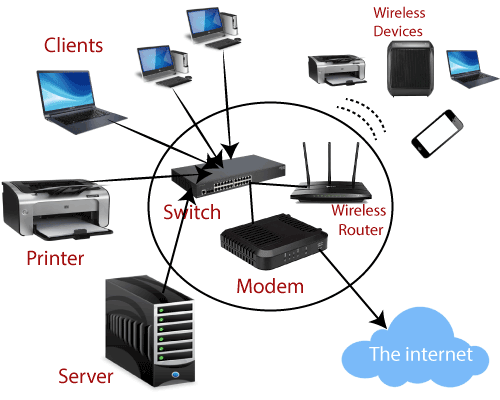Experience seamless connectivity and enhanced communication with our cutting-edge Local Area Network (LAN) solutions. Whether it's a bustling office building, a sprawling school campus, or a multi-floor corporate facility, our LAN setups empower you to create efficient computer networks tailored to your specific needs. Our LAN solutions enable seamless data sharing and resource access among connected devices, optimizing productivity and collaboration within your designated area. From switching and routing to network management, we ensure that your LAN operates with utmost efficiency and reliability.
Benefits of Embracing Local Area Networks:
- Resource Sharing: Our LAN solutions facilitate seamless resource sharing, allowing organizations to optimize the utilization of printers, scanners, and storage devices across multiple users, leading to increased efficiency and reduced costs.
- File and Data Sharing: Foster collaboration and streamline workflows with our LAN setups, enabling smooth sharing and access to files and data among networked computers, supporting your team's productivity.
- Centralized Management: With our LAN solutions, enjoy the benefits of centralized management, allowing you to efficiently handle network resources, user accounts, security policies, and software updates, simplifying network administration.
- Faster Data Transfer: Experience high-speed data transfer rates within your LAN, ensuring quick and efficient exchange of large files and multimedia content between networked devices, saving valuable time.
Types/Forms of Local Area Networks
- Ethernet LAN: The most common type of LAN technology, Ethernet, utilizes wired connections, such as Ethernet cables, to establish high-speed and reliable data transmission among connected devices.
- Wireless LAN (WLAN): Embrace the flexibility and mobility offered by WLANs, which use wireless technology like Wi-Fi to connect devices without the need for physical cables.
- Virtual LAN (VLAN): Simplify network segmentation and isolation with VLANs, creating logical subnetworks within a physical LAN based on factors such as departments, projects, or security requirements.
- Powerline LAN: Overcome connectivity challenges with Powerline LANs, leveraging existing electrical wiring in buildings to transmit data signals and provide network connectivity where Ethernet or wireless connections may be impractical.
- Campus Area Network (CAN): Extend your network coverage across multiple buildings or sites within a campus or localized area with CAN, catering to organizations with larger physical footprints.
Experience the power of our Wide Area Network (WAN) solution, designed to establish robust computer networks spanning vast geographical areas, connecting multiple cities, regions, or even countries. Our strategic WAN infrastructure seamlessly interconnects various Local Area Networks (LANs), enabling efficient long-distance communication and swift data transfer between dispersed locations.
Advantages of Embracing Wide Area Networks:
- Geographical Connectivity: Empower your organization to effortlessly connect geographically dispersed locations, including branch offices, remote sites, or data centers. Our WAN solution fosters seamless communication and data sharing across the entire network.
- Centralized Resource Access: With WANs, your users from different locations gain unified access to centralized resources such as servers, databases, and applications. This promotes collaboration and enhances overall productivity.
- Data Sharing and Replication: Benefit from efficient data sharing and replication across multiple locations, ensuring data consistency, backup, and disaster recovery capabilities.
- Scalability and Flexibility: Our WAN infrastructure offers scalability to accommodate your organization's growth and adaptability to evolving requirements. Adding new locations to the network and adjusting bandwidth become effortless processes.
Types/Forms of Wide Area Networks:
- Leased Line: Leased lines are dedicated point-to-point connections provided by telecommunications service providers, offering secure and high-speed data transfer. While effective, they can be relatively expensive.
- MPLS (Multi-Protocol Label Switching): This network protocol creates virtual private networks (VPNs) over a service provider's infrastructure, ensuring reliable and efficient data transfer with quality of service (QoS) guarantees.
- Virtual Private Network (VPN): Utilizing encryption and tunneling protocols, VPNs establish secure connections over public networks, such as the internet, enabling cost-effective and secure communication between different locations.
- Satellite Network: For remote or challenging geographical areas, WANs can be established using satellite connections. Satellite networks provide wide coverage, but may have higher latency compared to other options.
At our company, end-point equipment encompasses the devices and hardware utilized by individuals or end users to access and interact with ICT systems and services.
The combination of a robust ICT infrastructure and reliable end-point equipment ensures that organizations have a solid foundation for efficient and effective information and communication technology operations. It enables seamless connectivity, data management, collaboration, and productivity, contributing to overall business success.
